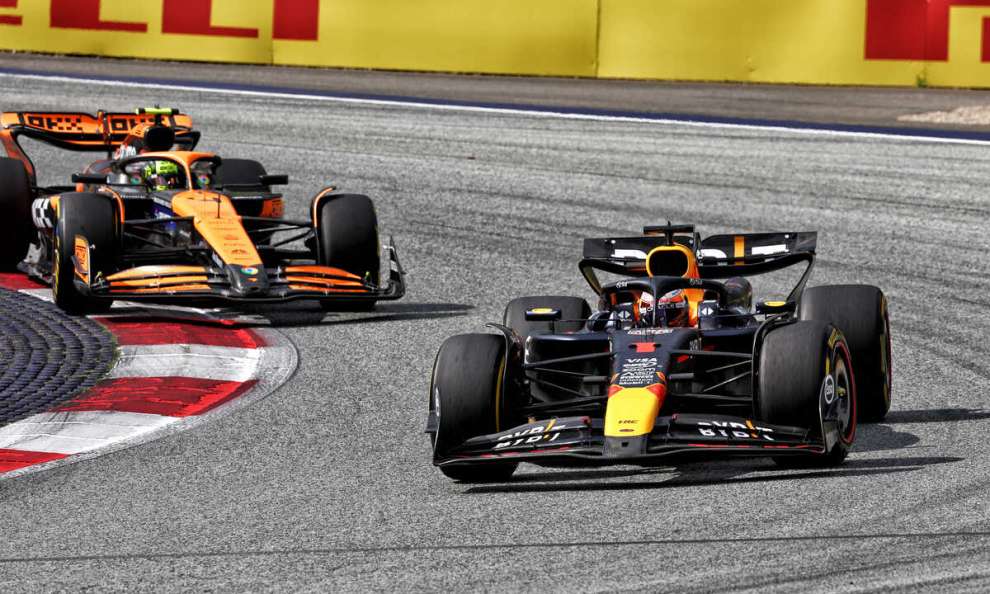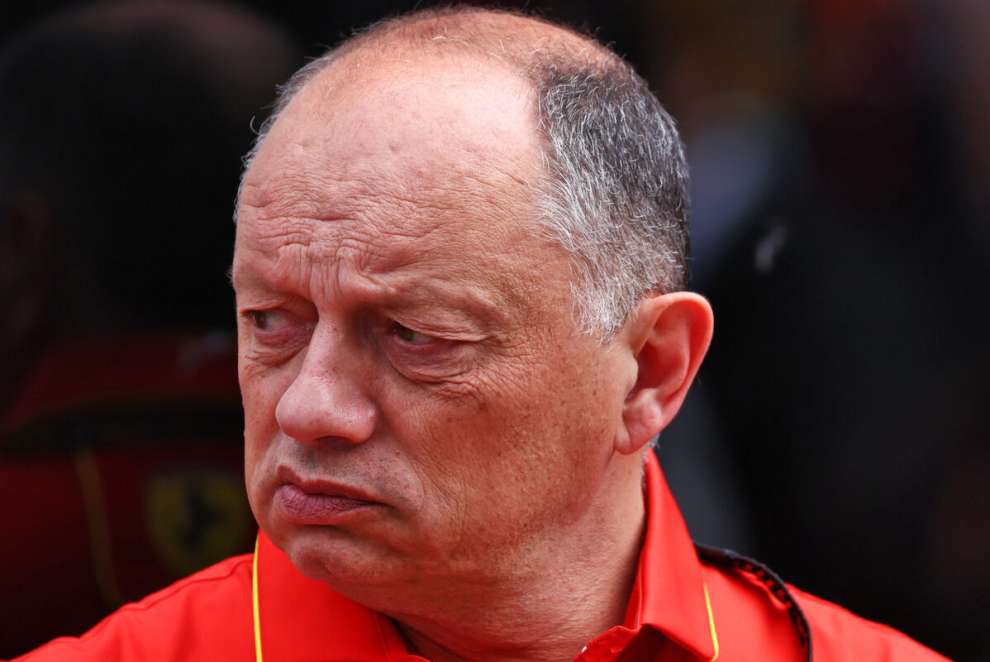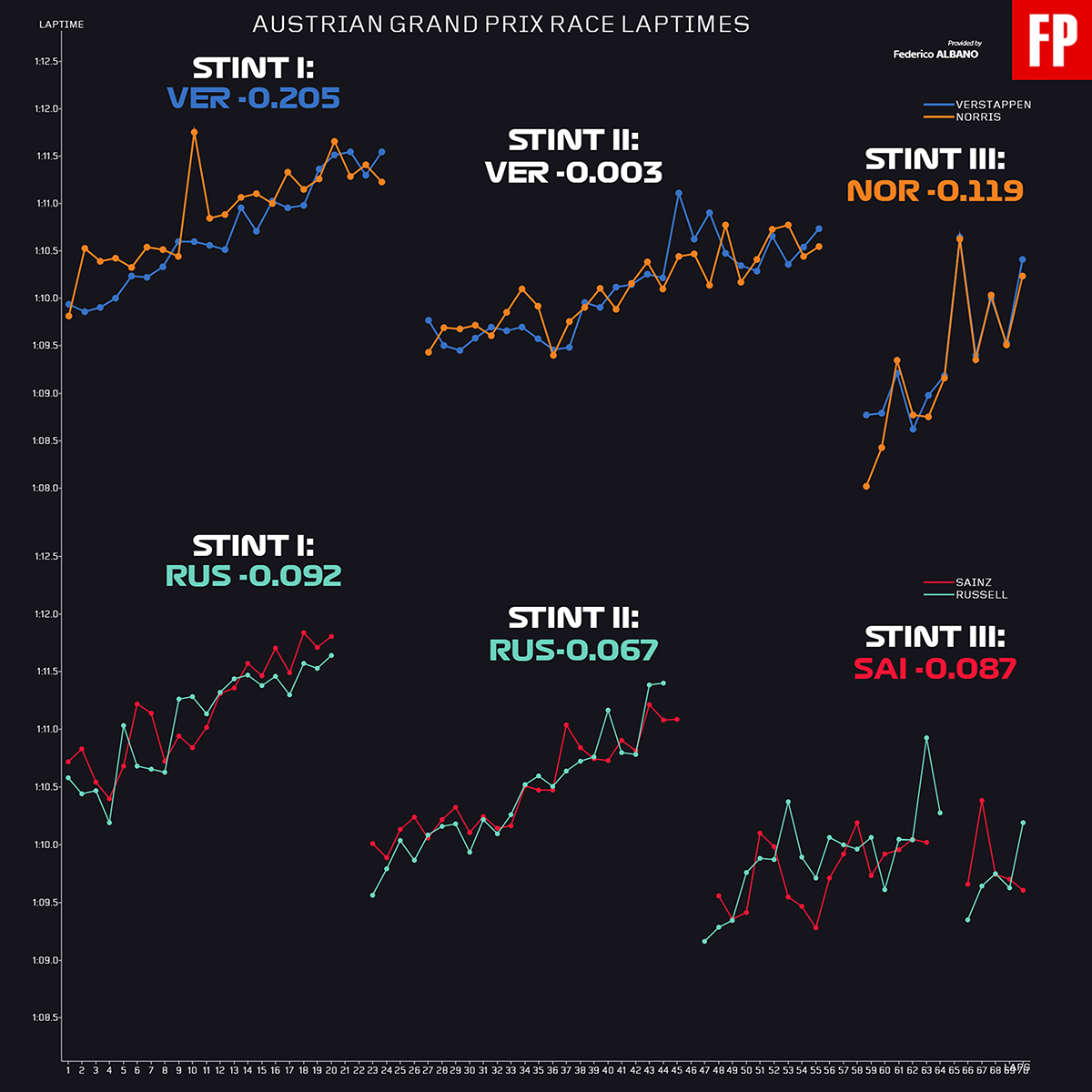Although the entire weekend of the Austrian Grand Prix seemed aimed at the return to dominance of Verstappen and the Red Bull the ending was a surprise, and, from some points of view, even the performances in the race were more in line with what was seen in this central phase of the championship, rather than with what happened at the beginning of the season. The Dutch champion had gained a gap of around 7 seconds on Norris, almost all in the first stint, and was preparing to manage the end of the race to contain the Briton’s return but a botched pit stop ruined Max and Red’s plans Bull. From then on the duel between Verstappen and Norris was rustic and old-fashioned. The championship leader defended himself by going beyond the limits of the regulation on at least a couple of occasions, while the aggressive Norris, eager to redeem himself after the mistake in the Sprint, attempted a couple of dives under braking without great results. That Verstappen was unfair is clear, but it is also true that Norris lacks that effective spark, which is essential when fighting with a tough guy like Max. For example, all of Norris’ attacks were on turn 3 because when braking for turn 4 the Englishman was unable to be more effective than Verstappen, but it is precisely on turn 4 that overtaking guarantees fewer chances of reply to those who suffer. In the end, Norris was never able to get his wheels in front of Verstappen, not even after the accident and, incredible to say, Verstappen gained more points over his direct pursuer with the accident than by winning the race with McLaren second. A dominant voice is that Max behaves like this every time someone tries to overtake him, but in our opinion this is not the reality. In recent years we have sometimes seen him even lift his foot to avoid problems, aware of a superiority that guarantees him easy comebacks or in any case does not compromise the ranking. Yesterday we saw Verstappen ready to do anything to avoid giving up his position and the conclusion is that when the threat is real, for the race or for the title, Max’s attitude changes and the old version re-emerges, the one that does not accept defeat. Yes, because the impression during the last stint of the race was that if Norris had managed to pass, it would not have been easy for Verstappen to challenge him again for the victory.
McLaren close to race despite Red Bull dominance in qualifying: soft tyre issue
Despite incredible dominance in qualifying, in fact, in the race Red Bull was stronger than McLaren only in the first stint, as the times demonstrate, thanks to better management of tire temperatures under full load and probably to a Verstappen who has something extra when the situation is very critical, such as with a full tank of fuel for example. But towards the end Norris and McLaren were on the rise. With a regular race the Briton would probably have come to battle for the lead only in the very last laps, a bit like in Imola, while the mistake in the Red Bull pit put him back in the race with almost 20 laps to go. Norris had a new tyre, against a 3-lap used one from Verstappen, but also in a stabilized phase, the McLaren was slightly faster in the final stintso much so that in the only moment in which Verstappen managed, by taking advantage of the overtaking, to take the DRS away from Norris, the latter needed only a few corners to grab hold of the exhausts of the number 1 single-seater again. Seeing the qualifying performances of light cars, this is a surprising fact from which we can deduce that the performance on the single lap was very much linked to extracting the peak from the very soft tyre (Pirelli brought the 3 softest compounds) in which Red Bull is evidently still superior to McLaren, something that does not happen when the compounds are harder and therefore more stable (with McLaren on pole in Spain where Pirelli had in fact brought the 3 hardest compounds in the range). For the championship, what happened is ultimately a big step forward for Verstappen, but McLaren continues to prove to be incredibly strong and complete, even when on the eve it seemed almost done for, and this can only mean that Verstappen will continue to play hard (and dirty) because the threat from the Woking team continues to be real in both championships. In short, it will not be surprising if what we saw in Austria is just a taste of what will happen in the second part of the season.
Mercedes third winning force, deserving of some good steps forward and not giving up
In the end the victory still went to George Russellwith a Mercedes just ahead of the Ferrari (from our calculations less than a tenth per lap) but with the merit of never having given up a meter throughout the race and throughout this first phase of the season. The black crisis Ferrari promotes the Brackley team to third force who, obviously, can seize these opportunities well, unlike the redhead who experienced a phase of enormous difficulty in Austria. However, Sainz was the protagonist of a solid and concrete weekend and deserved the result, even saying nice words after the race while Leclerc was blamed for a qualifying compromised by an attitude of giving everything for everything, when, moreover, it wasn’t of great useful given the simplicity of overtaking at the Red Bull Ring.

The Ferrari crisis
Coming now to the Maranello team, the situation does not seem simple. What happened is now clearly emerging both from the data and from the statements of the protagonists who, after an initial reticence, are beginning to confirm what the problem is that Ferrari is now suffering from. In practice, after an initial setting of the aerodynamic concept of a certain type, the result of what was also learned from the mistakes of 2023, in the first months of 2024 the Maranello engineers evidently found that the most profitable way to find aerodynamic load and performance was in in line with the winter revolution carried out by Red Bull and with a different concept. A path which, as we have already had the opportunity to tell, is compatible with the initial advantage in research and development of the Milton Keynes team over the competition. From there the race for updates began, with an SF-24 initially “abandoned” to the original version while the conceptual revolution was in the pipeline. In fact, it would have been useless and expensive to update the old concept while working full time on the new one. TO Imola Thus the first package arrived, which clearly had the intention of bringing the first improvements, but above all of modifying the aerodynamic map of the car to prepare it (the term that best conveys the idea is colloquial and forgive us but it is “preparing”) for what would come later. And in fact the Imola package brought a first step forward to the track, which seemed to direct everything towards the right path. After a mad rush of factory and suppliers, a Barcelona the package arrived that was supposed to be crucial, because it was aimed at a significant increase in downforce which would have positive cascading consequences, including, among other things, difficulties in qualifying. The problem arises precisely from this second package: the increase in load brought with it an aerodynamic rebound that was decidedly higher than any expectation. The suspension system, designed for the original SF-24 concept, does not seem able to support and tolerate the increase in load and the way it is generated by the new concept, especially when cornering. As a result, the load is there but the performance is destroyed by the rebound effect: to try to dampen the rebound, you can lift the car off the ground but with the consequence of losing load and efficiency, otherwise you have to try to grit your teeth but end up with a single-seater that with the bouncing becomes almost undriveable in fast corners given the continuous change of the aerodynamic map and the load oscillations that the driver cannot manage. The situation is dangerously similar to what we saw in Mercedes at the beginning of this regulatory era.with Lewis Hamilton who in fact said in interviews “It’s not a problem of lack of load, but if we add more instead of going faster we just bounce more”. However, this is a crucial and delicate moment for this and next season for Ferrari.

There is no turning back: this is the line and it serves as the basis for 2025
It is quite evident that there is no way back, as the identified path is probably the best one, as also indicated by the similarities with what we saw in Red Bull and McLaren, but the budget cap and the tight timeframe prevents a change in the suspension setup for this year. At the same time, even giving up any target for the current season, development must necessarily continue, given that the 2025 car will have the 2024 one as a starting point. It is no coincidence that Vasseur, answering the question posed by Vicky Piria on Sky Italy, have no doubts: “There is no going back, we must think about the future”. The question, therefore, is how to find a solution, if possible, with what the engineers at the red team currently have at their disposal. It is likely to think that a lot of work will be done on the set-ups, trying to revolutionize the settings used up to now, including stiffness, ride height and mechanical settings, perhaps giving up some performance peaks, in order to obtain a stable car and above all still developable, to continue in the evolutionary process both to continue trying to play something this season, but also, as mentioned, to not compromise next year from the start. The next race at Silverstone will put the SF-24 to the test because most of the corners on the splendid English circuit are high speed. The 3 free practice sessions could help find some remedy, which, at that point, should bring the car back to life. However, the attitudes between optimism and pessimism are not in agreement between Vasseur and the Ferrari drivers, with Sainz and Vasseur more positive than Leclerc in this case. It is certainly technically the most critical moment of Vasseur’s management so far, we will see how the French TP and the Maranello engineers will manage to finish the crossing and find the route again on the other bank of the difficult river they are crossing.
#Austria #analysis #Ferrari #middle #ford #Max #doesnt #lose
